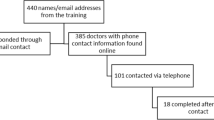Abstract
Hurricane Sandy led to the closing of many major New York City public hospitals including their substance abuse clinics and methadone programs, and the displacement or relocation of thousands of opioid-dependent patients from treatment. The disaster provided a natural experiment that revealed the relative strengths and weaknesses of methadone treatment in comparison to physician office-based buprenorphine treatment for opioid dependence, two modalities of opioid maintenance with markedly different regulatory requirements and institutional procedures. To assess these two modalities of treatment under emergency conditions, semi-structured interviews about barriers to and facilitators of continuity of care for methadone and buprenorphine patients were conducted with 50 providers of opioid maintenance treatment. Major findings included that methadone programs presented more regulatory barriers for providers, difficulty with dose verification due to impaired communication, and an over reliance on emergency room dosing leading to unsafe or suboptimal dosing. Buprenorphine treatment presented fewer regulatory barriers, but buprenorphine providers had little to no cross-coverage options compared to methadone providers, who could refer to alternate methadone programs. The findings point to the need for well-defined emergency procedures with flexibility around regulations, the need for a central registry with patient dose information, as well as stronger professional networks and cross-coverage procedures. These interventions would improve day-to-day services for opioid-maintained patients as well as services under emergency conditions.
Similar content being viewed by others
References
Cepeda A, Valdez A, Kaplan C, Hill LE. Patterns of substance use among hurricane Katrina evacuees in Houston, Texas. Disasters. 2010; 34(2): 426–446.
Weiss L, Fabri A, McCoy K, Coffin P, Netherland J, Finkelstein R. A vulnerable population in a time of crisis: drug users and the attacks on the World Trade Center. J Urban Health. 2002; 79(3): 392–403.
McNeely J, Gourevitch MN, Paone D, Shah S, Wright S, Heller D. Estimating the prevalence of illicit opioid use in New York City using multiple data sources. BMC Public Health. 2012; 12: 443.
Gonzalez-Sanchez A. Hurricane Sandy: the impact, lessons learned for New York State. OASAS. New York State Office of Alcoholism and Substance Abuse Services. Available at:http://www.nasmhpd.org/meetings/presentations/Commissioners%202013/Arlene%20Gonzal-ez-Sanchez_Monday.pdf. Accessibility verified June 26, 2014
Maxwell JC, Podus D, Walsh D. Lessons learned from the deadly sisters: drug and alcohol treatment disruption, and consequences from Hurricanes Katrina and Rita. Subst Use Misuse. 2009; 44(12): 1681–1694.
Rutkow L, Vernick JS, Mojtabia R, Rodman SO, Kaufmann CN. Legal challenges for substance abuse treatment during disasters. Psych Serv. 2012; 63(1): 7–9.
Toriello PJ, Morse PA, Morse EV, Kissinger P, Penderson-Wasson E. The resuscitation of a New Orleans substance abuse treatment agency after Hurricane Katrina. J Health Care Poor Underserved. 2007; 18(2): 482–486.
Frank B, Dewart T, Schmeidler J, Demirjian A. The impact of 9/11 on New York City’s substance abuse treatment programs: a study of program administrators. J Addict Dis. 2006; 25(1): 5–14.
Dewart T, Frank B, Schmeidler J. The impact of 9/11 on patients in New York City’s substance abuse treatment programs. Am J Drug Alcohol Abuse. 2006; 32(4): 665–672.
Clark HW. Office-based practice and opioid-use disorders. N Engl J Med. 2003; 349(10): 928–930.
Emerson R, Fretz R, Shaw L. Writing ethnographic fieldnotes. 2nd ed. Chicago, IL: University of Chicago Press; 2011.
Corbin J, Strauss A. Grounded theory in practice. New York, NY: Sage; 1997.
Lingard L, Albert M, Levinson W. Grounded theory, mixed methods and action research. BMJ. 2008; 337: a567.
Reeves S, Kuper A, Hodges BD. Qualitative research methodologies: ethnography. BMJ. 2008; 337: doi: 10.1136/bmj.a1020
Rieckmann TR, Abraham AJ, Kovas AE, McFarland BH, Roman PM. Impact of research network participation on the adoption of buprenorphine for substance abuse treatment. Addict Behav. 2014; 39(5): 889–896.
Ling W, Jacobs P, Hillhouse M, et al. From research to the real world: buprenorphine in the decade of the Clinical Trials Network. J Subst Abuse Treat. 2010; 38(Suppl 1): S53–S60. doi:10.1016/j.jsat.2010.01.009.
Acknowledgments
We wish to thank Ellie Grossman, Joshua Lee, Ronnie Swift, Jennifer McNeely, Babak Tofighi, Lauren Moy, Christina Ahn, Vishal Gupta, and Elspeth Kelly for making this work possible. This work was supported in part by a NIDA K01 award DA032674‐01 (to H. Hansen) and the NIDA Clinical Trials Network, U10 DA013035 (to J. Rotrosen and E. Nunes).
Author information
Authors and Affiliations
Corresponding author
Rights and permissions
About this article
Cite this article
McClure, B., Mendoza, S., Duncan, L. et al. Effects of Regulation on Methadone and Buprenorphine Provision in the Wake of Hurricane Sandy. J Urban Health 91, 999–1008 (2014). https://doi.org/10.1007/s11524-014-9904-5
Published:
Issue Date:
DOI: https://doi.org/10.1007/s11524-014-9904-5




